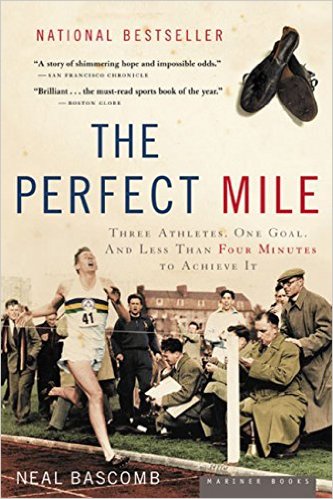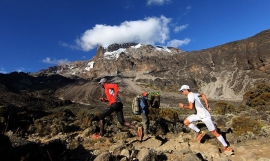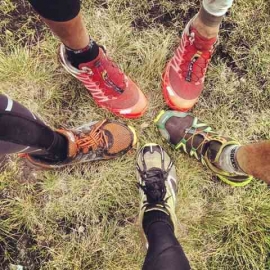The Perfect Mile: Three Athletes, One Goal, and Less Than Four Minutes to Achieve It电子书下载地址:
The Perfect Mile: Three Athletes, One Goal, and Less Than Four Minutes to Achieve It_Neal Bascomb_2005.pdf
//www.nduoke.com//www.nduoke.com/shujixiazai/0618562095-the-perfect-mile-download
There was a time when running the mile in four minutes was believed to be beyond the limits of human foot speed, and in all of sport it was the elusive holy grail. In 1952, after suffering defeat at the Helsinki Olympics, three world-class runners each set out to break this barrier. Roger Bannister was a young English medical student who epitomized the ideal of the amateur — still driven not just by winning but by the nobility of the pursuit. John Landy was the privileged son of a genteel Australian family, who as a boy preferred butterfly collecting to running but who trained relentlessly in an almost spiritual attempt to shape his body to this singular task. Then there was Wes Santee, the swaggering American, a Kansas farm boy and natural athlete who believed he was just plain better than everybody else.
Spanning three continents and defying the odds, their collective quest captivated the world and stole headlines from the Korean War, the atomic race, and such legendary figures as Edmund Hillary, Willie Mays, Native Dancer, and Ben Hogan. In the tradition of Seabiscuit and Chariots of Fire, Neal Bascomb delivers a breathtaking story of unlikely heroes and leaves us with a lasting portrait of the twilight years of the golden age of sport.
The Perfect Mile: Three Athletes, One Goal, and Less Than Four Minutes to Achieve It_Neal Bascomb_2005.pdf目录:
prologue ix
part i A REASON TO RUN ~ 1
part ii THE BARRIER ~ 69
part iii THE PERFECT MILE ~ 195
epilogue 256
Author’s Note 273
Acknowledgments 275
Notes 277
Index 307
The Perfect Mile: Three Athletes, One Goal, and Less Than Four Minutes to Achieve It 评价:
From Publishers Weekly
The attempt by three men in the 1950s to become the first to run the mile in less than four minutes is a classic 20th-century sports story. Bascomb's excellent account captures all of the human drama and competitive excitement of this legendary racing event. It helps that the story and its characters are so engaging to begin with. The three rivals span the globe: England's Roger Bannister, who combines the rigors of athletic training with the "grueling life of a medical student"; Australia's John Landy, "driven by a demand to push himself to the limit"; and Wes Santee from the U.S., a brilliant strategic runner who became the "victim" of the "[h]ypocrisy and unchecked power" of the Amateur Athletic Union (AAU). Although Bannister broke the record before Landy, Landy soon broke Bannister's record, and the climax of the book is a long and superb account of the race between the two men at the Empire Games in Vancouver on August 7, 1954. Bascomb provides the essential details of this "Dream Race"â€"which was heard over the radio by 100 million peopleâ€"while Santee, who may have been able to beat both of them, was forced by AAU restrictions to participate only as a broadcast announcer. Bascomb definitively shows how this perfect race not only was a "defining moment in the history of the mileâ€"and of sport as well," but also how it reveals "a sporting world in transition" from amateurism to professionalism.
Copyright © Reed Business Information, a division of Reed Elsevier Inc. All rights reserved. --This text refers to an out of print or unavailable edition of this title.
From The New Yorker
On May 6, 1954, Roger Bannister, a British medical student who squeezed in track workouts between hospital rounds, became the first man to run a mile in less than four minutes. It was a feat that had widely been thought impossible, but within seven weeks an even faster time was posted by the Australian John Landy, setting up a showdown later that year in a race that was billed as the "Mile of the Century." In masterly fashion, Bascomb re-creates the battle of the milers, embellishing his account with fascinating forays into runner's lore. (In the seventeenth century, athletes had their spleens excised to boost speed; in the nineteenth, they were advised to rest in bed at noon naked.) It's a mark of Bascomb's skill that, although the outcome of the race is well known, he keeps us in suspense, rendering in graphic detail the runners' agony down the final stretch.
Copyright © 2005 The New Yorker
Review
'Bascomb succeeds in seducing the reader into sympathising with them all and feeling involved in their individual stories' The Spectator 'The Perfect Mile is as inspiring as it is accurate and evocative' Athletics Weekly magazine 'Bascomb lets his wonderful story and its characters do the talking' Sunday Telegraph --This text refers to an out of print or unavailable edition of this title.
About the Author
NEAL BASCOMB is the New York Times bestselling author of Hunting Eichmann, The Perfect Mile, Higher, and Red Mutiny, among others. His books have won several national awards and been published in over twenty countries. A former international journalist, he is a widely recognized speaker on the subject of World War II. He lives in Seattle, Washington.
Excerpt. © Reprinted by permission. All rights reserved.
Prologue
How did he know he would not die?” a Frenchman asked of the first runner to break the four-minute mile. Half a century ago the ambition to achieve that goal equaled scaling Everest or sailing alone around the world. Most people considered running four laps of the track in four minutes to be beyond the limits of human speed. It was foolhardy and possibly dangerous to attempt. Some thought that rather than a lifetime of glory, honor, and fortune, a hearse would be waiting for the first person to accomplish the feat.
The four-minute mile: this was the barrier, both physical and psychological, that begged to be broken. The number had a certain mathematical elegance. As one writer explained, the figure “seemed so perfectly round—four laps, four quarter miles, four-point-oh-oh minutes —that it seemed God himself had established it as man’s limit.” Under four minutes—the place had the mysterious and heroic resonance of reaching sport’s Valhalla. For decades the best middle-distance runners had tried and failed. They had come to within two seconds, but that was as close as they were able to get. Attempt after spirited attempt had proved futile. Each effort was like a stone added to a wall that looked increasingly impossible to breach.
But the four-minute mile had a fascination beyond its mathematical roundness and assumed impossibility. Running the mile was an art form in itself. The distance—unlike the 100-yard sprint or the marathon —required a balance of speed and stamina. The person to break that barrier would have to be fast, diligently trained, and supremely aware of his body so that he would cross the finish line just at the point of complete exhaustion. Further, the four-minute mile had to be won alone. There could be no teammates to blame, no coach during halftime to inspire a comeback. One might hide behind the excuses of cold weather, an unkind wind, a slow track, or jostling competition, but ultimately these obstacles had to be defied. Winning a footrace, particularly one waged against the clock, was ultimately a battle with oneself, over oneself.
In August 1952 the battle commenced. Three young men in their early twenties set out to be the first to break the barrier. Born to run fast, Wes Santee, the “Dizzy Dean of the Cinders,” was a natural athlete and the son of a Kansas ranch hand. He amazed crowds with his running feats, basked in the publicity, and was the first to announce his intention of running the mile in four minutes. “He just flat believed he was better than anybody else,” said one sportswriter. Few knew that running was his escape from a brutal childhood.
Then there was John Landy, the Australian who trained harder than anyone else and had the weight of a nation’s expectations on his shoulders. The mile for Landy was more aesthetic achievement than footrace. He said, “I’d rather lose a 3:58 mile than win one in 4:10.” Landy ran night and day, across fields, through woods, up sand dunes, along the beach in knee-deep surf. Running revealed to him a discipline he never knew he had.
And finally there was Roger Bannister, the English medical student who epitomized the ideal of the amateur athlete in a world being overrun by professionals and the commercialization of sport. For Bannister the four-minute mile was “a challenge of the human spirit,” but one to be realized with a calculated plan. It required scientific experiments, the wisdom of a man who knew great suffering, and a magnificent finishing kick.
All three runners endured thousands of hours of training to shape their bodies and minds. They ran more miles in a year than many of us walk in a lifetime. They spent a large part of their youth struggling for breath. They trained week after week to the point of collapse, all to shave off a second, maybe two, during a mile race—the time it takes to snap one’s fingers and register the sound. There were sleepless nights and training sessions in rain, sleet, snow, and scorching heat. There were times when they wanted to go out for a beer or a date yet knew they couldn’t. They understood that life was somehow different for them, that idle happiness eluded them. If they weren’t training or racing or gathering the will required for these efforts, they were trying not to think about training and racing at all.
In 1953 and 1954, as Santee, Landy, and Bannister attacked the four-minute barrier, getting closer with every passing month, their stories were splashed across the front pages of newspapers around the world, alongside headlines about the Korean War, Queen Elizabeth’s coronation, and Edmund Hillary’s climb toward the world’s rooftop. Their performances outdrew baseball pennant races, cricket test matches, horse derbies,, rugby matches, football games, and golf majors. Ben Hogan, Rocky Marciano, Willie Mays, Bill Tilden, and Native Dancer were often iiiiin the shadows of the three runners, whose achievements attracted media attention to track and field that has never been equaled since. For weeks in advance of every race the headlines heralded an impending break in the barrier: “Landy Likely to Achieve Impossible!”; “Bannister Gets Chance of 4-Minute Mile!”; “Santee Admits Getting Closer to Phantom Mile.” Articles dissected track conditions and the latest weather forecasts. Millions around the world followed every attempt. When each runner failed—and there were many failures—he was criticized for coming up short, for not having what it took. Each such episode only motivated the others to try harder.
They fought on, reluctant heroes whose ambition was fueled by a desire to achieve the goal and to be the best. They had fame, undeniably, but of the three men only Santee enjoyed the publicity, and that proved to be more of a burden than an advantage. As for riches, financial reward was hardly a factor—they were all amateurs. They had to scrape around for pocket change, relying on their hosts at races for decent room and board. The prize for winning a meet was usually a watch or a small trophy. At that time, the dawn of television, amateur sport was beginning to lose its innocence to the new spirit of “win at any cost,” but these three strove only for the sake of the attempt. The reward was in the effort.
After four soul-crushing laps around the track, one of the three finally breasted the tape in 3:59.4, but the race did not end there. The barrier was broken, and a media maelstrom descended on the victor, yet the ultimate question remained: who would be the best when they toed the starting line together?
The answer came in the perfect mile, a race fought not against the clock but against one another. It was won with a terrific burst around the final bend in front of an audience spanning the globe.
If sport, as a chronicler of this battle once said, is a “tapestry of alternating triumph and tragedy,” then the first thread of this story begins with tragedy. It occurred in a race 120 yards short of a mile at the 1,500- meter Olympic final in Helsinki, Finland, almost two years to the day before the greatest of triumphs.
Copyright © 2004 by Neal Bascomb. Reprinted by permission of Houghton Mifflin Company.
--This text refers to an out of print or unavailable edition of this title.
The Perfect Mile: Three Athletes, One Goal, and Less Than Four Minutes to Achieve It 评论:
Based on ample first-hand details gleaned from interviewing Roger Bannister, John Landy and Wes Santee, "The Perfect Mile" provides a nuanced character study of what drives these three great men toward breaking the most elusive of athletic goals: the four-minute-mile. While serious students of the sport will know the outcome of this tale before reading it, Neal Bascomb is able to create and maintain a fair amount of suspense by allowing the reader to experience events leading up to the 1954 Empire Games showdown from three very different perspectives.
Roger Bannister is the thinking man's runner, with the classic middle distance athlete's long stride and finishing kick as well as insights into the scientific principles that underlie cardiovascular exertion. These strengths, however, are offset by the demanding medical studies that severely limit his training time and by his tendency to become overwrought before big races.
John Landy is the workhorse of the trio, logging more miles than the others and able to bring a single-minded focus to the task. But he lacks the closing speed and power of the classic milers, forcing him to run the legs out of his competitors from the front.
Wes Santee, the least famous and accomplished of the three, may well be the most talented. Yet the demands of his University of Kansas track schedule, military commitments, and confrontations with track and field's governing body are impediments that prove too difficult to overcome.
For me, the best part of this book was the fact that these three men pursued this historic goal in a noble and dignified fashion that made you really pull for each of them somehow to be the first. None of the spoils of today's professional athletes was available, so each of them was motivated by the simple ideal of achieving the impossible. I also admired the way in which the author tied this athletic quest to the world events of the 1950s, creating a strong resonance between the historic events taking place on the track and the happenings in the politics and culture of the times.
The Perfect Mile is about the conquest of the four-minute mile, which like the ascent of Mt. Everest, stood in the early 50s as one of the last great frontiers of human endeavor. Three runners emerged as candidates to be the first to break through this barrier. One, Roger Bannister, was British. A full-time medical student and intern, he approached sport of track as the last of the consummate amateurs in the traditional mold. He had little coaching and devised his own training methods. Perceived by many in England as the potential resurrection of British athletics, in a sad state at the time, he carried the heavy load of hopeful expectations thrust upon him by a grim British nation suffering through post-war shortages and austerity. Considered aloof by his enemies in the British press, he possessed two powerful secret weapons: an advanced medical knowledge of the causes of and the techniques to combat fatigue and muscle failure, and an incredible capacity to ignore pain in the late stages of a race and unleash an extraordinary kick.
The Australian, John Landy, competed by seeing to it that he was the best conditioned athlete on the track. In the early 50s Australia was an athletic backwater. After returning home to Australia from the disappointment of failing to even make the semifinal qualifying heat in the mile at the 1952 Helsinki Olympics, Landy embarked on a brutal training regimen, inspired by the physical fitness guru and great Czech runner Emil Zatopek who won gold at Helsinki in the 5000 meter, 10,000 meter and marathon events, and who Landy humbly approached as an acolyte near the close of the games. By the time the 4-minute mark was in Landy's sights, he was winning almost all of his races as "the human rabbit", leading from the starting gun and simply running the legs off his competition by setting a punishing pace.
The American, Wes Santee, was the youngest and probably the most naturally gifted of these runners. He competed for the University of Kansas, and was soon breaking records, including the world record for the 1500 meter event, and the American collegiate mile record, which he took from the legendary Glenn Cunnningham, former holder of the world record for the mile. Intensely competitive, Santee loved big crowds and high-impact races. His biggest handicaps were his cold and totally unsupportive father, and even worse, the AAU (Amateur Athletic Union), led by the ogre-ish Avery Brundage, which controlled U.S. track and field, and all eligibility for the Olympics with an iron fist. As Santee became more and more famous and independent, he began to be perceived more as a threat than as an asset to the power structure of so-called amateur athletics in America.
The perfect mile is a terrific page-turner and is packed with goodies from beginning to end. The writing is pitched just right: flowing, colorful, detailed, not dry, and never simplistic or trite. It starts with a brief thumbnail history of the mile event and the thinking that led many to believe of the 1886 record of 4:12.75, which stood for 31 years, "the probability is that this record will never be beaten." The complexity of each of the three milers' motivations is given breadth and scope, with particular attention given to the humiliating experience each suffered at the Helsinki Olympics. And The Perfect Mile doesn't stop with the breaking of the 4-minute mark, which occurs about halfway through the book. The second half of the book leads up to the inevitable showdown on the same track, the "perfect mile" of the title, one of the great classic races of all time. For each of these racers a victory in this showdown would have an intensely personal meaning as a reaffirmation or as a vindication of what they had achieved.
Although it helps to be interested in track (as is yours truly, although I have never run a race in my life), The Perfect Mile, like the very best sports books, is not ultimately about sport, but about the human beings who compete in it for a rich variety of human reasons.
更多跑步书籍见://www.nduoke.com//www.nduoke.com/running-books
跑步书籍下载见://www.nduoke.com//www.nduoke.com/shujixiazai
跑步书籍百科见://www.nduoke.com//www.nduoke.com/shujibaike
跑步书籍下载地址合集 ://www.nduoke.com//www.nduoke.com/shujixiazai/download
跑步书籍汇集大全附下载 ://www.nduoke.com//www.nduoke.com/running-books/daquan




